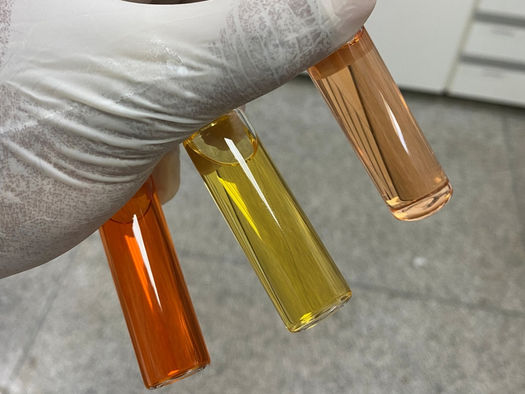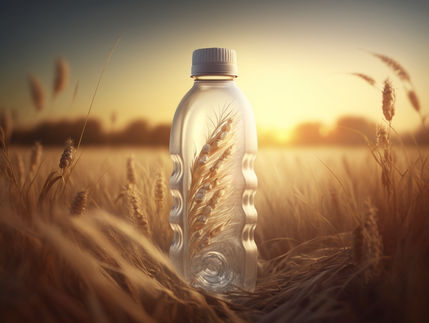“Green” solvent and natural pigment to produce bioplastic
Scientists based in Brazil and Portugal have developed an environmentally sustainable process to produce biodegradable plastic using pigment extracted from yeast by “green” solvents. In an article published in the journal Green Chemistry, they show that this biodegradable plastic could in future be used in smart packaging with antioxidant and anti-microbial properties.

The process is sustainable (right to left: flasks containing astaxanthin, beta-carotene, and a blend of both pigments extracted from P. rhodozyma yeast)
Cassamo Mussagy
With similar applications to those of conventional plastics derived from oil, gas and coal, which take hundreds of years to decompose, sustainable bioplastics produced from sugarcane, corn and potatoes are starting to become commercially available.
After more than eight years of research, the scientists demonstrated that eutectic solvents can efficiently extract two carotenoids, astaxanthin and beta-carotene, from biomass of the yeast Phaffia rhodozyma.
Carotenoids are a class of more than 750 naturally occurring pigments synthesized by plants, algae and photosynthetic bacteria. They account for the yellow, orange and red colors of many plants. They have commercial applications in the food, cosmetics and pharmaceutical industries, among others.
According to the researchers, eutectic solvents can be used both to extract the pigments and to produce biodegradable plastic film based on bioactive starch without any need for additional purification.
“We demonstrated as proof of concept that it’s possible to produce a natural pigment by means of a sustainable process. We worked with two lines. One was production of yeast-based pigments and extraction of these economically valuable natural compounds using eutectic solvents, which are a blend of biocompatible and biodegradable components. The other was utilization of the extracts to produce biomaterials such as the starch-based bioplastic,” said Jorge Fernando Brandão Pereira, a professor in the Department of Chemical Engineering at the University of Coimbra’s School of Science and Technology in Portugal, and one of the corresponding authors of the article, alongside Cassamo Ussemane Mussagy.
FAPESP supported the research via four projects (20/08655-0, 19/15493-9, 18/06908-8 and 15/11759-3).
The research is part of Mussagy’s postdoctoral work at the University of São Paulo (USP) in collaboration with São Paulo State University (UNESP), under the supervision of Professor Adalberto Pessoa Junior.
“We set out to find alternatives to synthetic pigments and the extraction processes that use polluting solvents. We worked with sustainable methods to obtain natural pigments and apply them in the production of biodegradable plastic using green solvents,” Mussagy told Agência FAPESP.
Pigments have been used for centuries to enhance or restore the appearance of different products and guarantee uniformity. As consumers increasingly seek healthier or more nutritious products, while also trying not to harm the natural environment, synthetic pigments are being replaced by natural compounds that are ecofriendly and are also biologically active in the sense of having antioxidant and anti-microbial properties.
According to the researchers, scientific studies aiming at the production or extraction of natural pigments from microorganisms will help expand the supply of bioplastics. Also known as biopolymers, these products currently account for less than 1% of the more than 367 million metric tons of plastic manufactured every year worldwide, according to European Bioplastics, which represents the interests of some 70 member companies.
According to some estimates, production of bioplastics will rise from 2.42 tons in 2021 to 7.59 million tons in 2026, in response to the rise in demand for alternative materials from the packaging, appliance and textile industries, as pressures increase to reduce the use of plastics derived from petroleum, owing to pollution and non-degradable waste.
Development of novel biopolymers is the focus for a research group led by Rondinelli Herculano, a professor at UNESP who collaborated on the development of the starch-based bioplastic.
Some 11 million metric tons of plastic were thrown away in 2018 in Brazil, corresponding to 13.5% of total waste in the year and making Brazil the fourth-largest producer of plastic waste in the world. The estimate is from the Brazilian edition of Plastic Atlas, published in November 2019 by Heinrich Böll Foundation, a German NGO.
Plastic pollution is a growing threat to all ecosystems, especially the oceans, where it accounts for 85% of total waste, according to the United Nations.
“Industrial production processes are always aggressive even if the product is biodegradable,” Pereira said. “Paper, for example, is renewable and recyclable, but in almost all cases it’s produced by non-sustainable methods that consume huge amounts of energy, water and toxic chemicals. Our study demonstrates the possibility of obtaining bioplastics via an integrated and sustainable platform.”
The process
The scientists produced the carotenoids by growing Phaffia rhodozyma in a bioreactor. They then used ionic liquids, choline-based eutectic solvents and butyric acid to extract the pigments from the yeast. Choline is a vitamin B-like nutrient produced by the human organism and found in nature.
Ionic and eutectic liquids are considered ideal solvents for the extraction of compounds from natural matrices, thanks mainly to their capacity for solvation, a process whereby solvent molecules surround and interact with solute ions or molecules, or an ionic compound dissolves in a polar substance without forming a new one.
To maximize retrieval of astaxanthin (one of the most important natural antioxidants produced by yeasts and microalgae) and beta-carotene, the researchers tested five biomass-solvent (solid-liquid) concentrations, considered a key parameter in cell rupture procedures to retrieve intracellular molecules from microbial biomass. The concentration that increased in both was up to 0.2 g mL−1 of wet yeast cells.
“We used the biosolvents so that the pigment was extracted from the yeast biomass and could be applied. We detected that the solvent with the best result both extracted the pigment from the biomass of the microorganism and also acted as a plasticizer for packaging,” said Valéria de Carvalho Santos Ebinuma, a professor at UNESP and a co-author of the Green Chemistry “Hot Article”.
“Constant long-term investment is needed if we want to foster first-class research, so FAPESP’s support is important,” Mussagy said. “After years of research on the development of sustainable processes to produce and extract pigments from microbial sources, we’ve seen our work recognized by a science journal that’s one of the best 5% in the field of sustainability.”
For Pereira, the multidisciplinary approach used in the study is important. “It’s a reward for Mussagy’s steady efforts, and shows the importance of synergy between institutions and researchers,” he said.
Mussagy said next steps will focus on application of the results to show that packaging with this type of “green” plastic can be used for various purposes, not least by the food industry.






























































